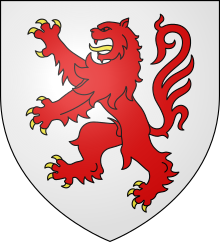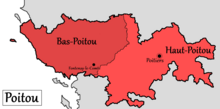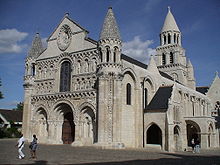Poitou

The Poitou ( French name for Piktavien , Celt. Piktavia , old norw./norm. Peitaland ) is a landscape in western France and was a historical province and county. The area of the county corresponded roughly to the present-day departments of Deux-Sèvres , Vienne and Vendée , with the exception of the old Seneschallate of Loudun , which belonged to the province of Anjou . The capital of the former province of Poitou was Poitiers . Today the Pictavian ('Poitevinian') language is still spoken.
The departments of Deux-Sevres and Vienne formed by the end of 2015 along with the south bordering departments Charente and Charente-Maritime region of Poitou-Charentes (since 2016 the region Nouvelle-Aquitaine is one) while the Vendée to the region Pays de la Loire came .
The Île d'Yeu is also part of the historical province of Poitou.
location
The historical landscape of the Poitou is bounded in the north by the Nantais (area around Nantes ), the County of Anjou and the Touraine , in the east by the Berry and the Limousin and in the south by the Charente and the Saintonge . The area is divided into the flat and late populated marshland and alluvial land of Bas-Poitou with the center of La Roche-sur-Yon in the west and the historically and culturally significant hilly Haut-Poitou with the center of Poitiers in the east.
history
In late antiquity, the region belonged to the Roman province of Aquitania secunda as civitas Pictavorum and comprised six pagi . After the Great Migration, the area belonged to the Visigoth Empire and after their defeat in the Battle of Vouillé in 507 (near Poitiers) to the Empire of the Franks .
Saint Warin of Poitou was governor of the Merovingian King of Paris for Poitou in the 7th century.
In the adjacent Touraine, the battle of Tours and Poitiers took place in 732 between the advancing Arabs and the army of the Frankish princes led by Charles Martel . In this battle, the Muslim-Arab expansion in Western Europe via Andalusia was limited and turned.
Due to its size, the county of Poitou was one of the most important territories of the Frankish empire of the Carolingians and was part of the sub-kingdom of Aquitaine . In addition to the Counts of Auvergne from the Wilhelmiden family (Gellones) , the Counts from the Ramnulfiden family (House of Poitiers) were the most powerful princes of Aquitaine in the 9th century and at times carried the title of Dux , although without any specific assignment, as the dukes Aquitaine was first brought by the Gellones. Only after the Gellones died out in 927 did Ebalus Mancer take over their possessions, establishing his family as a new ducal dynasty.
From the 10th to the 12th centuries, the Counts of Poitou, as dukes of Aquitaine, were the most powerful princes in south-west France alongside the rival Counts of Toulouse and enjoyed a de facto sovereign status due to the weakness of the early Capetian kings. The family also includes the princes of Antioch from 1163 to 1268, the counts of Tripoli from 1187 to 1289, the kings of Cyprus from 1217 to 1489 and thus also the titular kings of Jerusalem from 1268.
The most famous family members, however, are two women: Agnes von Poitou († 1077), the Roman-German Empress and regent of the Holy Roman Empire from 1056 to 1062, and Eleanor of Aquitaine († 1204). Through the marriage of Eleonores with Heinrich Plantagenet (1152) and his accession to the throne as the English king (1154), the Poitou and the rest of Aquitaine were included in the territorial conglomerate of the Plantagenets , now known as the " Angevin Empire ". Together with her son, Richard the Lionheart , Eleonore ran one of the most splendid courts of the high Middle Ages in Poitiers. In the power struggle with King Philip II of August , the Plantagenets were declared forfeit of all their possessions in France in 1204, but only Phillip's son, King Louis VIII the Lion , was able to conquer Poitou militarily in 1224. In the Treaty of Paris 1259 this loss was made by King Henry III. recognized by England .
After the dissolution of the historical provinces during the French Revolution , the name of the province continues to be used as a geographical name.
Attractions
While cultural tourism is in the foreground in the historical landscape of the Haut-Poitou, in Bas-Poitou it is mainly bathing and recreational tourism. Interesting and historical places are:
- Haut-Poitou
Poitiers , Chauvigny , Saint-Savin-sur-Gartempe , Montmorillon , Civray , Thouars , Argenton-les-Vallées , Airvault , Saint-Loup-Lamairé , Saint-Jouin-de-Marnes , Bressuire , Parthenay , Melle , Niort
- Bas Poitou
La Roche-sur-Yon , Luçon , Fontenay-le-Comte , Vouvant , Les Sables-d'Olonne , Noirmoutier-en-l'Île
Also known are the Poitevini swamps ( Marais Poitevin ) with drainage canals , a marshland (partly bird sanctuary) on the Gulf of Poitou on the French west coast north and northeast of La Rochelle .
Personalities
- Jehan Daniel (~ 1480– ~ 1550), organist and composer
- René Goulaine de Laudonnière (1542–1582), writer and colonizer
See also
literature
- Robert Favreau: Poitou . In: Lexicon of the Middle Ages (LexMA). Volume 7, LexMA-Verlag, Munich 1995, ISBN 3-7608-8907-7 , Sp. 45-48.
Web links
Coordinates: 46 ° 34 ′ 52 ″ N , 0 ° 20 ′ 7.1 ″ E

